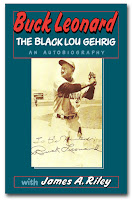It seems like it will forever be Buck Leonard's fate to be known in terms of someone else. While playing for the Homestead Grays between 1934 and 1950, Leonard was called "the black Lou Gehrig" to pair with Josh Gibson, "the black Babe Ruth." Gibson and Leonard batted third and fourth for the Grays for many years and formed a very dangerous heart of the order for opposing pitchers. Nowadays, Leonard might be more likely to be thought of as "the other Buck," to avoid confusion with the Kansas City Monarchs' Buck O'Neil, one of the best-known ambassadors of the Negro Leagues during the 1990s and 2000s.
But Leonard was his own man, working from age 13 on to help support his widowed mother and five brothers and sisters before deciding to try to make a living playing baseball. He hooked on with the Grays in 1934 and began posting stellar batting averages; despite Gibson's deadly power few tried to pitch around him because Leonard would make them pay for the move. Leonard was offered a major-league contract in 1952 but figured that at age 45 he would not perform well enough to continue making the argument that African-American players deserved the same shot at baseball glory as everyone else.
Touches like that are some of the best parts of Riley's 1995 co-authored autobiography of Leonard, in which the author serves more as an interview transcriber than anything else. While Leonard is clear that many of the Negro League's best players could have excelled on any major league team and some of them, like Gibson or Satchel Paige, might have dominated, he has no illusions about the playing level of the leagues overall. Few Negro League teams would have regularly competed for titles if they had been transferred directly into the majors, Leonard said, because the mid-level Negro League players didn't match their journeymen American and National League counterparts.
The reality of segregation in the US during these years also meant, Leonard said, that most Negro League players did not spend a lot of their time wishing they could play in the majors. That's probably the most damning testimony to the evil of the practice -- some of the sport's greatest players simply accepted they'd never be given the chance to show themselves as such until they were too old for it to matter.
Leonard's hometown had not offered high school for African-Americans so his education had ended with the eighth grade. During his playing career, though, he had earned his GED and following his playing days worked for schools and founded a realty company. He was also an owner of the minor-league Rocky Mountain Leafs. Leonard died in 1997 at the age of 90. He had been elected to the Hall of Fame in 1972 along with his late teammate Gibson.
-----
Twelve years younger than Leonard, Monte Irvin had been considered as one of Branch Rickey's candidates to break the color barrier established by unspoken agreement in baseball in the 1880s. But the skills he had demonstrated playing for the Newark Eagles during the late 1930s and 1940s had eroded during his wartime service, and Eagles co-owner Effa Manley wouldn't allow him to sign a contract with the Brooklyn Dodgers farm system unless her team was compensated.By the time that Irvin felt he was ready for top-level competition again, Rickey had signed Jackie Robinson and Manley's threatened lawsuit pushed him to drop any work with Irvin. The New York Giants signed him instead, and he debuted in 1949. The next year, he was called up to a regular position with the Giants and played with them until 1955. Giants manager Leo Durocher assigned Irvin an unofficial role as mentor for the young Willie Mays, both on and off the field, and Mays frequently lays some of his success in baseball on Irvin's early help.
With Riley's help, Irvin describes these parts of his life in the 1996 Nice Guys Finish First and goes on to detail his work as a scout for the New York Mets in the late 1960s and as a public relations specialist for then-commissioner Bowie Kuhn in the 1970s. Kuhn's absence when Hank Aaron hit his record-breaking 715th home run in 1974 meant that Irvin was the one to present him with baseball's official recognition. Irvin was elected to the Hall of Fame in 1973 and currently serves on its Veterans Committee.
Learning that Monte Irvin is a nice guy is no great revelation to anyone who followed his career. The book provides an interestingly different look at Jackie Robinson from the perspective of a competitor. The Dodgers-Giants rivalry carried a lot of energy and while Irivin's respect for Robinson's abilities as a player and pioneer clearly shows, it's also clear he wouldn't canonize his frequent opponent. And Irvin echoes Leonard's opinion that while the Negro Leagues had players who would easily rank with the best around, he thinks its brand of individual-heavy, team-light baseball would have a tough time competing. Negro League players benefited from time in the minors when major league teams signed them, but more for the experience playing in the major-league system and style than for any development of playing skills.
Irvin is 96 as this is written and is the oldest living member of the 1954 New York Giants World Series team, which finished out its regular season with a blistering September largely fueled by his hitting.



No comments:
Post a Comment